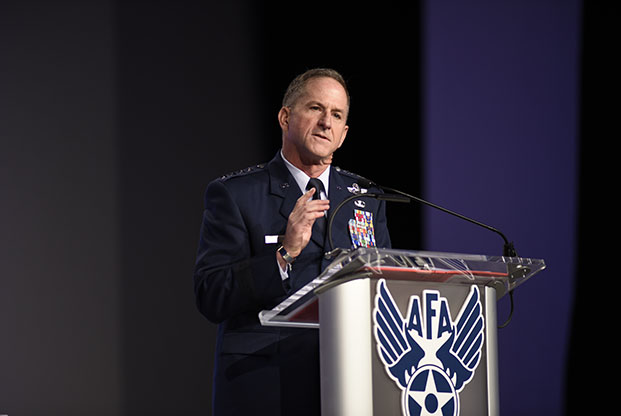
Chief of Staff of the Air Force Gen. David Goldfein discusses issues facing USAF at AFA's Air, Space & Cyber Conference in National Harbor, Md., on Sept. 18. Staff photo by Mike Tsukamoto.?
To go with Monday’s announcement that the Air Force must grow about 25 percent in the next 12 years, Chief of Staff Gen. David Goldfein on Tuesday announced a substantial? overhaul of the Air & Space Expeditionary Force model which has governed service deployments in evolving ways since the mid-1990s.
“Over time, we have migrated away from expeditionary forces,” Goldfein said, as the AEF evolved into an equitable method of meeting—service insiders say “crowdsourcing”—combatant commander needs for Air Force capabilities. It has focused on forces, often at the individual level, “falling in on” well-established bases with a healthy infrastructure, he said.
“We know how to … fight the base and operate under attack,” Goldfein said. But the “next fight” will require a shell game, where many small units disperse to many small and likely austere airfields, taking with them only so much support gear and people as they require.
“There will be few … established bases,” and few of the amenities USAF units have become accustomed to having when they deploy, Goldfein said. These detachments of units—Goldfein did not specify their size, though he suggested squadrons would be their building block— would “reach back” to Stateside bases for command and control and other support.
“It’s time to return to our expeditionary roots,” he declared.
The new units will have “flexibility and scalability” to address whatever demands the regional commander makes, Goldfein said. This new “mindset” will in turn drive everything from the kinds of equipment USAF buys to the nature of its exercises, how inspections are conducted, and other aspects of readiness. Units will deploy together, rather than deploy as aggregations of individuals rounded up from all over the Air Force, he said.
The Air Force will be “adapted and updated” from the old AEF, and this change will be “led by our MAJCOM commanders,” according to Goldfein. But squadrons “must be ready to operate independently.” There will also be “expeditionary groups and wings” to go with the new paradigm, and one of their key responsibilities will be base defense in “multiple layers.” They must be “the best in the world at defense” and Goldfein declared this to be “the year of the defender.” These units in turn must be practiced and linking with other joint forces in an expeditionary setting, he said.
Goldfein said not to fear the restructure, for while it represents a “seminal shift” in how USAF postures itself, “we’ve done this before.” It is part of USAF’s culture to “think outside the box—and maybe throw the box away.”
He concluded, “The fight is coming, and we have from this moment to get ready.”